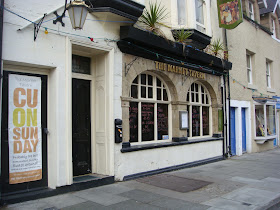A little bit of history.
The origins of Hartlepool can be traced back to the 7th
century AD when an Abbey was founded by St Aidan on the headland overlooking
the sea. The monastery became famous under St Hilda, who served as its abbess
from AD 649 to AD 657. By the early 19th century, Hartlepool was
still a small town with less than 1000 people. A rapid expansion occurred with
the industrial revolution when a solicitor from Stockton-on Tees, Ralph Ward
Jackson, developed a harbour at West Hartlepool for the export of coal. The
area became heavily industrialized with ironworks and shipbuilding featuring
strongly. Many of Hartlepool’s pubs were built around this time.
The Shades Hotel on Church Street in 1988. This old
pub, built in the mid-19th century and refaced at the start of the
20th century, has several Art Nouveau features and was Grade II
listed in 1985.
The Shades Hotel, Hartlepool, in 1988
Note the wonderfully delicate female figures on the window surround
The Volunteer Arms on Church Street in1988
The Stranton pub and adjoining Camerons Brewery in
1988
John William Cameron took over an existing brewery in
1865. In 1892, the present Lion brewery was built, incorporating the most
up-to-date equipment. An artesian well has supplied water to the brewery for
over 160 years. The Stranton was converted to a visitors’ centre in 2004.
During the late 1960s and early 1970s, I had a holiday
job at Camerons Brewery. This was a Victorian brewery with equipment from that
era, so the work was quite physical and included shovelling spent grain from
the mash tub and cleaning the inside of the coppers. Both jobs required you to
strip down to jeans and wellies and enter the still steamy vessel by descending
a pair of ladders. A large wooden shovel was used to remove the spent grain,
while the spent hops were blasted from the walls of the copper using a water
hose. The next stage was to clean any remaining hops from the heating pipes
with a small piece of Scotchbrite. Much of the transport of barley and hops was
also done by hand, as the design of the building did not permit the use of
mechanized transport. Although the work could be hard, it was never boring. However,
the best job was in the afternoon. The directors met each day at 4 o’clock
precisely, and one lucky employee was required to deliver two large jugs of
Camerons Strongarm to the board room. The perk of the job was that you were
allowed a swift half pint when you filled the jugs. Over time, the half pint slowly increased to
two or three pints, with a subsequent delay in delivery to the directors. This
was eventually noticed and an improvement in my performance was ordered!
Major changes were made in 1970. Much of the Victorian
brass and copper fixtures had been replaced by electronically-operated, fully
automatic, stainless steel brewing equipment. This modernization was not universally
welcomed, however, for although the job had become physically easier, it was extremely
tedious with much of the day spent washing the new marble floors or cleaning
the stainless steel vessels.
The Zetland on Church Street in1988
The New Market on Lynn Street in 1998, looking a
little past its best,
but still a Grade II listed building
but still a Grade II listed building
The Harbour of Refuge in April 2012
A bronze statue of Andy Capp,
the cartoon creation of Hartlepudlian, Reg Smythe, was unveiled in the
old town in June 2007
The characters, Andy and his wife
Flo, were based on Smythe's own parents.
Apart from success in the UK, Andy
Capp became popular internationally in over
30 countries and 700 newspapers.
30 countries and 700 newspapers.
The Cosmopolitan in Old Hartlepool in April 2012
The Ship in Old Hartlepool in April 2012
The Ship showing a lamp advertising the now demolished
Vaux brewery
The Fisherman’s Arms in Old Hartlepool in April 2012
The Rat Race Alehouse in Hartlepool Railway Station in
April 2012. This is now my favourite pub in the town. They only serve real ale, wine, real cider
and perry. In fact, their marketing seems to be based on what they don’t have. This includes fizzy lager, fizzy
cider, fizzy beer, alcopops, music and a big screen TV. If, however, you would
like to enjoy an excellent pint with good conversation and papers and books to
read, then this is the place for you.
The Town Wall in 2012
A little bit of history courtesy of Wikipedia and some
local history websites.
After the Norman conquest of 1066, the de Brus family gained ownership of
the lands surrounding Hartlepool. William the Conqueror built Durham Castle and
brought stability to the area, and the surrounding villages were first
mentioned in records in 1153 when Robert de Brus, 1st Lord of Annandale, became
Lord of Hartness.
By the time of the Middle Ages, Hartlepool had grown into a small, but
important, market town with the improved harbour which served as the official
port of the County palatine of Durham.
The main trade was fishing,
making Hartlepool one of the major ports in the east of the UK. After two
hundred years, the de Brus connection with Hartlepool was severed when ‘Robert
the Bruce', the legendary Scottish hero and last Lord of Hartness, was crowned
King of Scotland, in 1306. Angered by this, King Edward I confiscated his title
to Hartlepool.
The Sandgate in 2012
The Town Wall which guards the Headland (Old
Hartlepool) was originally built in the 14th century as a defence against the
raiding Scots and some parts of the wall, including the historic Sandgate,
dates from this period.


































